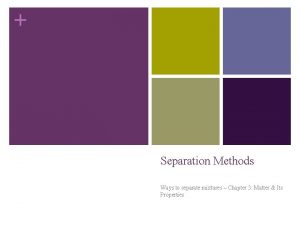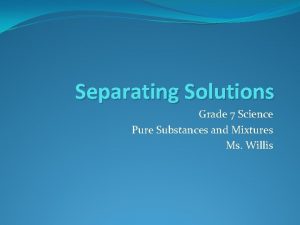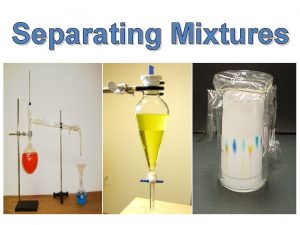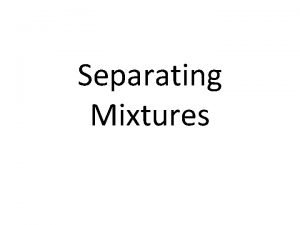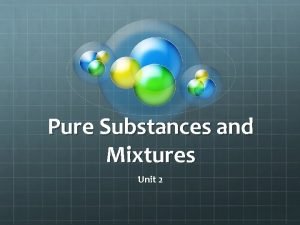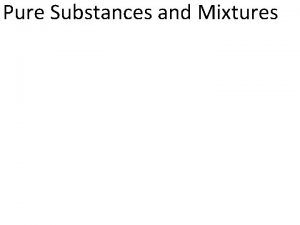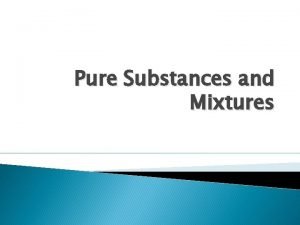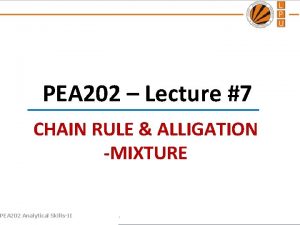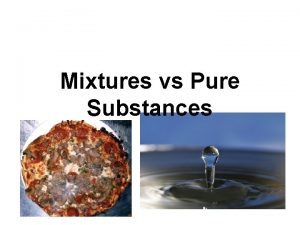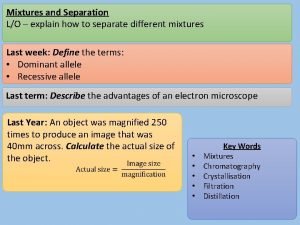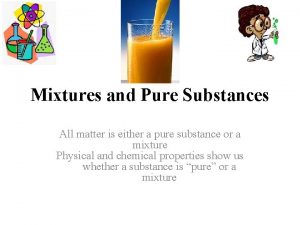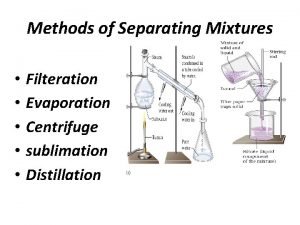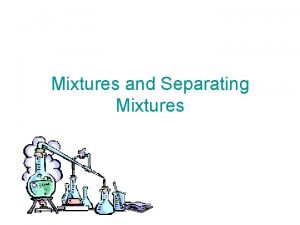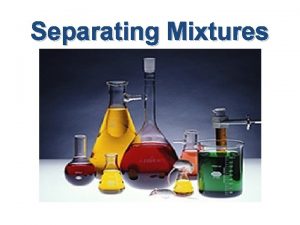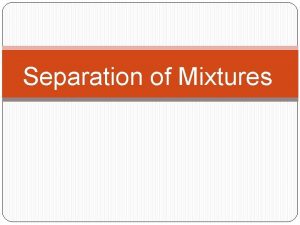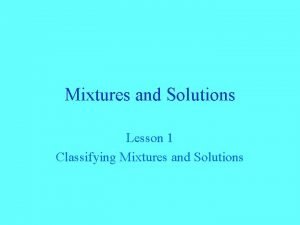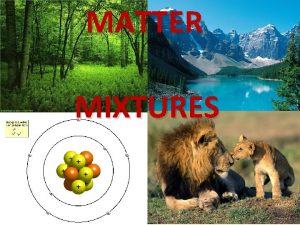Lesson 18 Changing Mixtures Lesson 18 Changing Mixtures






















- Slides: 22

Lesson 18 Changing Mixtures

Lesson 18 - Changing Mixtures You will investigate how adding salt affects the melting and boiling points of water. You will also investigate the melting points of three different tin alloys.

Lesson 18 - COS 1. 0 1. 1 1. 2 1. 3 1. 4 1. 5 6. 0 7. 0

Objectives • Measure the effect of different quantities of salt on melting and boiling points. • Compare the melting points of different alloys. • Discuss the technological applications of solutions and other mixtures.

Getting Started • Answer the following in your notebook: A. Can you think of at least one mixture that has the properties of “both” substances from which it is composed? B. Can you think of at least one mixture that has the properties of only “one” of the substances from which it is composed? C. Can you think of at least one mixture that has properties completely “different” from the properties of the substances from which it is composed?

Lesson 18 alloy - solutions of solid metals metal - group of elements; usually hard solids; have common characteristics shiny, good conductivity, and malleability concentration – the amount of a particular substance in a given quantity of mixture smelting – The process by which a metal is extracting from ore. It involves heating the ore, usually with a source of carbon.

Lesson 18. 1 Does adding salt change the melting point of ice?

Lesson 18. 1 If…. . then…. because…

SAFETY • Wear your safety goggles throughout the lesson. • Carefully follow your teacher’s instructions for the use of burners. • Tie back long hair. • Be careful when handling hot objects.

Lesson 18. 1 1. Label beaker A and beaker B. 2. Place a small amount of ice in each beaker. 3. Place a thermometer in each beaker. Measure the temperature of the ice in each beaker. 4. Add 2 teaspoons of salt to Beaker A only. 5. Observe and record the temperature of the ice in each beaker. 6. After observing for several minutes, add another 2 teaspoons of salt to Beaker A. 7. Observe and record the temperature.

Lesson 18. 1

Lesson 18. 1 • Adding salt to ice lowers the melting point. The change in the melting point of a solvent is directly proportional to the amount of solute in the mixture.

Lesson 18. 2 Does adding salt change the boiling point of water?

Lesson 18. 2 If…. . then…. because…

Lesson 18. 2 1. Pour 100 m. L of hot water in a 250 -m. L beaker. Place a thermometer in the beaker. 2. Ignite the alcohol burner. 3. Place thermometer and beaker on the stand heat the water until it boils. 4. Predict what will happen if you add 2 teaspoons of salt to the boiling water. 5. Add 2 teaspoons of salt to the water. Observe the boiling water and thermometer. Record observations. 6. Add an additional 2 teaspoons of salt to the boiling water. Record observations.

Lesson 18. 2

Lesson 18. 2 • The boiling point of water rises when salt is added to water because solute particles interfere with the evaporation of a solvent.

Lesson 18. 3 Do all metal alloys have the same melting point?

Lesson 18. 3 If…. . then…. because…

Lesson 18. 3 Follow procedure in Student Book, pp. 155 -156.

Lesson 18. 3

Lesson 18. 3 • The properties of a mixture can be very different from the properties of the individual components that make up the mixture. • An alloy is a mixture that contains at least one metal………………
 What changes occurred in nimmi's family
What changes occurred in nimmi's family The roaring twenties lesson 3 changing ways of life
The roaring twenties lesson 3 changing ways of life How many elements
How many elements Are all solutions homogeneous mixtures
Are all solutions homogeneous mixtures Red and blue marbles of same size and mass
Red and blue marbles of same size and mass Decanting
Decanting Is maple syrup a pure substance
Is maple syrup a pure substance What happens in evaporation
What happens in evaporation Evaporation in separating mixtures
Evaporation in separating mixtures Examples of sifting mixtures
Examples of sifting mixtures Can sulfur and water be separated by filtration
Can sulfur and water be separated by filtration Mixtures vs compounds
Mixtures vs compounds Honey homogeneous or heterogeneous
Honey homogeneous or heterogeneous Pure substances and mixtures worksheet answers
Pure substances and mixtures worksheet answers Example of pure substance
Example of pure substance Alligation rule
Alligation rule Properties of materials grade 7 natural science
Properties of materials grade 7 natural science Is gatorade a heterogeneous mixture
Is gatorade a heterogeneous mixture Is salad dressing a homogeneous mixture
Is salad dressing a homogeneous mixture Properties of mixtures
Properties of mixtures Pure substance
Pure substance What is mechanical mixtures
What is mechanical mixtures Centrifugation separating mixtures
Centrifugation separating mixtures





